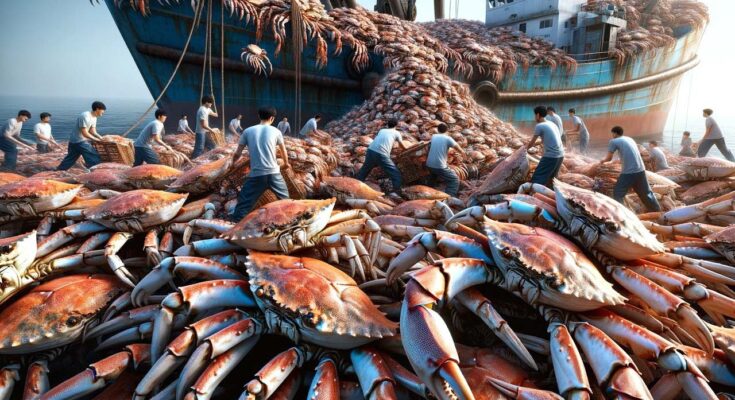More than 131,000 tons of delicious seafood—that’s how much lobster and crab U.S. fishermen catch every year. But within this impressive catch lies a unique fact: there’s one of these creatures you can technically eat more than once in its lifetime. We’ll get to that fascinating mystery later in this article. Join me as we jump on board with U.S. fishermen to discover how they have managed to harvest billions of amazing crabs and lobsters for centuries and deliver them fresh to our tables.
First, let’s meet the stars of the show: the iconic lobsters. The U.S. boasts two incredible varieties. There’s the East Coast’s Maine lobster, instantly recognizable by its cartoonish large claws, and the Sunshine State’s Florida spiny lobster, known for its irresistible tail meat. Both are world-renowned delicacies enjoyed fresh or frozen year-round.
Our adventure begins at the crack of dawn, 3:30 a.m. to be precise. Seasoned fishermen start their productive day with a several-hour trip to the lobster harvest site. Their target: lobster traps strategically placed on the seabed 2 to 3 days prior. Each trap has a brightly colored buoy, a unique identifier registered to each fisherman to avoid any underwater mix-ups. These lobster traps, essentially large underwater cages, are baited with a surprisingly familiar attractant: fish like mackerel, herring, and even smelly fish heads are common choices. Some lobstermen even get creative, mixing them with cat food. This irresistible scent lures lobsters inside, but the traps are designed with biodegradable panels and escape vents to allow any undersized lobsters to slip back into the ocean unharmed.
Once the traps are retrieved and the lobsters are sorted, only those meeting size regulations are kept. This practice helps maintain the lobster population and ensure a sustainable fishery. Undersized lobsters, known as “shorts,” along with egg-bearing females, are promptly returned to the sea. These regulations play a crucial role in preserving lobster stocks for future generations.
Next, let’s turn our attention to the fascinating world of crabs. In the U.S., crabbing is a significant industry with several species being harvested, including the blue crab, Dungeness crab, and the prized Alaskan king crab. Crabbing techniques vary depending on the species and location, but they all share a common goal: capturing these delicious crustaceans in a way that is sustainable and efficient.
For instance, Alaskan king crab fishermen brave the treacherous waters of the Bering Sea during a short but intense season. They use large, sturdy pots to catch these giant crabs. The pots are baited and set on the seabed, much like lobster traps, and left for a few days before being hauled back up. The crabs are then sorted by size, with undersized crabs being released to continue growing.
One of the most interesting aspects of crab fishing is the unique feature that allows for the sustainable harvest of certain species, such as the Alaskan king crab. Fishermen are able to harvest the male crabs while leaving the females and smaller males to ensure the population remains healthy. This practice is vital for the conservation of crab populations and the long-term viability of the industry.
Now, let’s address the intriguing fact mentioned earlier. There is one sea creature that you can technically eat more than once in its lifetime: the stone crab. Stone crabs, found predominantly in Florida, have a remarkable ability to regenerate their claws. Fishermen carefully remove one claw from each crab and then release the crab back into the ocean, where it will eventually grow a new claw. This sustainable practice allows stone crab populations to thrive while still providing a delicious delicacy for seafood lovers.
As we wrap up our journey, it’s clear that U.S. fishermen have developed sophisticated methods and strict regulations to ensure the sustainable harvest of lobsters and crabs. These efforts not only support the livelihoods of those working in the industry but also ensure that future generations can continue to enjoy these delectable seafood treasures.
So next time you savor a succulent lobster tail or indulge in a plate of steamed crabs, remember the incredible journey these creatures took from the depths of the ocean to your plate. And appreciate the dedication and hard work of the fishermen who make it all possible.



